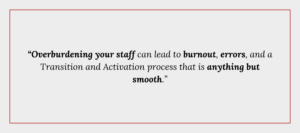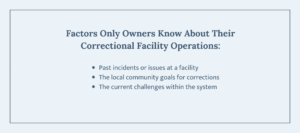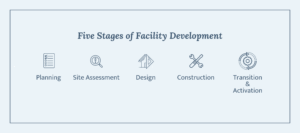
Navigating Transition and Activation Pt 2: Common Mistakes and Best Practices
Welcome back to our blog series on Transition and Activation (T&A) services for new justice facilities. If you’ve been with us since Part One, you’re already clued into the four main stages that make up the Transition and Activation process. Today, in Part Two, we cover some common mistakes that facility Owners and administrators might make and reveal the best practices to ensure a seamless Transition and Activation experience. Let’s correct some common misconceptions and set the stage for success.
Mistake #1 – Believing Transition and Activation is Only Something You Need to Think About When Nearing the End of Your Development Project
Best Practice: The best strategy is to consider Transition and Activation from the project’s inception.
Why It Matters: There are five stages to facility development that most are aware of: planning, site assessment, design, construction, and then Transition and Activation. But in that order, it looks like Transition and Activation happens afterwards. It really does not. The notion that Transition and Activation is an afterthought fails to recognize that this process is crucial to the operational readiness of your facility. By waiting until the end, you risk overlooking critical elements of operational planning, staff training, and system testing.
The earlier that the Transition Team can sit and be part of the planning process, the better off your project is going to go. It’s important to realize that Transition and Activation must happen during every single stage of the facility development lifecycle to be fully successful. Getting the team involved as early as possible will save on change orders in the construction process, meaning it’s going to save costs in the long-run and prevent time delays in the construction process.
How well a new detention facility operates can be directly tied to the effectiveness of the Transition and Activation process. Even skillfully designed and well-constructed new facilities can have significant operational shortcomings if the Transition and Activation process is poorly implemented.
Lessons Learned: Consider the impact on housing unit names. An architect’s blueprint will have an initial, default building and room numbering system. If the Transition and Activation Team doesn’t align those with their operational naming conventions from the start, it can become quite a headache down the line – the architect’s numbering system will become the de facto system input into the facility information systems and painted on buildings and rooms. When the names don’t match, confusion ensues, leading to communication breakdowns, inefficiency, and errors as systems come online. Involving the Transition Team early on in the project allows for valuable input that prevents these types of oversights.
Mistake #2 – Thinking ‘Move Management’ Only Needs to Occur During the Final Stage of the Transition and Activation Process

Best Practice: To help guarantee a smooth transition into the new facility, it’s best for Move Management to unfold simultaneously with the initial three stages of Transition and Activation.
Why It Matters: As I mentioned in Part One of our Transition and Activation series, the Transition and Activation process is comprised of four stages: Operational Planning, Procurement and Preparing for Fit-Up, Activation, and Move Management. Many may incorrectly assume this means that Move Management happens last and is more of a concluding phase to the Transition and Activation process. This couldn’t be further from the case.
Move Management encompasses the orchestration of transferring staff, equipment, and supplies from the current premises to the new establishment. Making sure everyone in the current facility has an assigned seat in the new facility and the resources required to be successful. However, Move Management is not just about physical relocation; it’s about ensuring continuity of operations, which is critical in a justice facility setting. When left for the last stage, the move can be disruptive and costly.
Just like Transition and Activation should play a role in every part of the facility development process, Move Management should play a role in every part of the Transition and Activation process itself. Integrate Move Management early on and let it run concurrently with the other three stages of T&A. Develop a phased move schedule that aligns with your operational needs and allows for flexibility and testing. The Transition Team is instrumental in managing this process and reducing any interruptions to operations.
Lessons Learned: Imagine the chaos if equipment crucial for day-to-day operations is moved without a backup in place. Critical data systems go offline, security monitoring is interrupted, and essential staff find themselves without the tools they need — all because Move Management wasn’t considered early enough during the Transition and Activation process. Poorly-timed moves can affect staff acclimation, security protocol establishment, and could potentially result in operational downtime — a non-starter for any justice facility.
Mistake #3 – Not Including the Right Mix of People on Your Transition Team

Best Practice: Assemble a cross-functional team early on, one that represents all facets of facility operations, including frontline staff, management, and support services. This team should have the authority to make decisions and the insight to consider all angles of the transition.
Why It Matters: It’d be incorrect to think that a Transition Team is simply a task force of whoever is available. It’s much more than that and should include stakeholders who have intimate knowledge of the needs of both staff and incarcerated persons within the facility. These stakeholders can provide invaluable input regarding space utilization, safety considerations, and workflow optimization.
A successful transition requires a diverse team with specific skills and decision-making authority. Without the right team composition, you’ll likely encounter bottlenecks in decision-making, inadequate representation of operational perspectives, and potentially a lack of buy-in from essential personnel. The lack of a diverse Transition Team could negatively impact everything from the design of staff training programs to the efficiency of the facility layout — ultimately affecting the day-to-day operations and safety.
Lessons Learned: A non-diverse team can miss critical issues and neglect crucial operational, security, and staff welfare considerations. A facility might end up with high-tech software or security systems, yet staff untrained in their operation; or designers could overlook incarcerated persons’ movement routes, compromising safety and efficiency because the team didn’t include operational expertise.
Mistake #4 – Assuming Existing Internal Staff Will Be Sufficient to Manage the Transition and Activation Process

Best Practice: Acknowledge the need for dedicated resources. Whether it’s allocating full-time internal roles for the transition duration or bringing in external expertise, ensure that the team has the focus and time required for a comprehensive Transition and Activation process.
Why It Matters: Being a part of a Transition Team is a worthwhile, yet very time-consuming effort. Frequently, this involves committing to multiple full-time, 40-hour/week roles, which can pose difficulties for Owners who have limited or overstretched personnel. Current staff are expected to take on the additional workload of managing Transition and Activation processes on top of their regular duties. This expectation underestimates how complex and demanding the Transition and Activation process can be. Overburdening your staff can lead to burnout, errors, and a Transition and Activation process that is anything but smooth.
Lessons Learned: Inadequate staffing can stall staff training, system testing, and even the basic setting up of administrative processes, ultimately compromising the facility’s start-up efficiency. Relying on overburdened internal staff to manage the Transition and Activation process might mean that they don’t have the time or expertise to develop a thorough training program for new security technology. When the facility launches, the staff might be unfamiliar with the advanced features of the security systems, which could lead to a significant lapse in the facility’s operational security during the initial weeks.
Mistake #5 – Owners Not Being Involved Directly in the Process and/or Expecting a Third Party to Handle Everything on Their Behalf

Best Practice: Owners must stay engaged throughout the process, working in tandem with their Transition Team, including any outside consultants, to ensure that decisions reflect the facility’s needs and culture.
Why It Matters: Many Owners believe they can hand off the entire Transition and Activation process to an internal Transition Team or independent third party, removing themselves from the day-to-day decision-making and oversight. While the Transition Team and third-party experts play a crucial role, the Owner’s direct involvement is vital for aligning the transition with the facility’s mission, values, and long-term goals.
Hiring an outside consultant can help bring clarity and organization to the process, which can seem overwhelming at times. However, it’s important for Owners to recognize that the consultant is there to guide the process and keep the team on track, ensuring everyone’s heard and that the end results reflect the needs of the agency and building inhabitants. The consultant should provide added value and cohesion to the process, not replace the role of the Owner or other vital decisionmakers on the team. An Owner’s disengagement can lead to misalignment between the facility’s operational goals and the implemented Transition and Activation plan, potentially impacting everything from staff morale to the quality of inmate care.
Lessons Learned: While third-party expertise is invaluable, the Owner’s insight, authority, and vision are irreplaceable in guiding a facility’s transition effectively and sustainably. No one can replace an Owner’s understanding of the factors that have shaped their correctional facility operations. These can include a wide variety of factors, such as past incidents or issues at a facility, the local community goals for corrections, and the current challenges within the system. The overall success of the project is linked to the Owner’s involvement in the Transition and Activation.
To Sum It Up
The journey through Transition and Activation is a path best navigated with forethought and active engagement. It requires time and effort, often more than any one individual or internal team can spare without risking the project’s success. A dependable, thorough Transition and Activation process is the foundation for a facility that’s not just new, but ready to serve its purpose effectively and safely.





